Ending a professional relationship with a contractor can be stressful, especially if deadlines slip or quality expectations aren’t met. Learning to fire contractor correctly can save your business from costly delays and unnecessary complications.
Around 70% of companies report wasting time and resources due to inefficient processes – a problem that skilled outsourcing can solve.
Switching to dependable solutions like virtual assistants allows you to streamline tasks and get back on track quickly.
Whether you need help managing projects, handling campaigns, or getting day-to-day operations in order, Stealth Agents provides experienced virtual assistants to keep your business running smoothly. Don’t spend another moment dealing with incomplete work or poor communication.
Book a free consultation today to learn how our affordable virtual assistant pricing and services can ease your workload and give you peace of mind!
What Is the Process to Fire a Contractor?
Fire contractor requires clear communication, proper documentation, and adherence to the terms of your agreement to avoid disputes. Reviewing the signed contract thoroughly helps ensure compliance with termination protocols, such as required notice periods or valid reasons.
Documenting any performance issues or breaches is essential, which may be critical if legal actions arise.
According to research, about 68% of disputes in business relationships stem from a lack of clear communication or unmet expectations. When exploring how to fire contractor arrangements professionally, a termination letter should clearly and politely outline the reasons and next steps.
Consulting legal counsel or a C-suite executive recruiter can provide valuable insights if the contractor’s role is tied to critical operations.
Lastly, maintaining respect and professionalism throughout the process is essential to protect your business reputation and foster future opportunities.
How Can Businesses Benefit From Firing a Contractor Properly?
When a contractual relationship isn’t working out, terminating it wisely can make a critical difference for your business. Fire contractor responsibly preserves your company’s reputation and sets a standard for professionalism. Below are the key areas where businesses benefit when the process is handled correctly.
✅ Preserving Brand Reputation
Handling a contractor termination with care ensures your business reputation remains intact internally and externally.
According to a study by Glassdoor, 75% of job seekers research a company’s reputation before deciding to work with them. A professional and respectful approach to ending contracts demonstrates your organization’s commitment to fairness.
Contractors often share their experiences with others in their network, making positive closures essential to avoid negative word-of-mouth.
Employers who operate transparently during these times show integrity, which attracts high-quality talent in the future. Providing proper notice and clear communication minimizes misunderstandings and eases the transition for both parties.
Even after the contract ends, the way you part ways can have a long-lasting impact on your standing in your industry. This process can even turn a tricky situation into one where mutual respect flourishes.
✅ Avoiding Legal Complications and Financial Losses
Properly managing contractor terminations helps businesses reduce the risk of legal challenges and associated costs.
Research shows that 45% of small businesses face legal disputes annually, and many are tied to poorly handled terminations. By learning how to fire contractor agreements legally, you protect your company from contract breaches or wrongful termination claims.
Following the conditions specified in the contract guarantees a damage-free and orderly division. Consulting HR outsourcing companies for small businesses ensures you stay informed about compliance requirements during the termination process.
These services also guide managing payroll finalizations, reducing headaches related to tax or payment disputes.
Solid legal protections set the stage for smoother transitions so your focus can return to business growth. Financial resources saved through proper termination procedures can be reallocated towards strengthening other business areas.
✅ Improving Team Morale and Productivity
Poor handling of contractor terminations can dampen workplace morale, leading to drops in overall productivity.
According to Gallup, businesses with low morale see up to 21% less profitability than high-engagement workplaces. Demonstrating professionalism during terminations fosters transparency, ultimately building trust among your employees and collaborators.
Teams who see ethical behavior modeled by leadership are likelier to remain engaged and motivated. Open conversations help teams fully understand their roles, especially when other collaboration tools for virtual assistants or contractors are needed to redistribute workload.
Proper documentation and detailed feedback during termination ensure teams stay aligned towards common goals.
These practices reduce gossip or confusion, keeping a positive work environment intact. High employee morale boosts retention and creates a more productive operational structure.
✅ Strengthening Vendor and Contractor Relationships
Handling contractor terminations correctly can improve long-term relationships with other vendors or freelancers.
A 2022 report by Upwork found that 72% of freelancers value feedback and professional behavior over compensation alone. Providing constructive feedback during terminations leaves contractors with actionable insights they can utilize.
Contracts that end may open doors for future collaborations under better circumstances. Businesses that maintain open communication encourage trust and continue to build a network of reliable contractors or vendors.
Honest feedback and professionalism can even result in recommendations and referrals from departing contractors.
Responsible endings show your company honors commitments, strengthening future partnerships’ foundations. Investing effort in ethical treatment pays dividends, creating a reputation of excellence within freelancer and vendor communities.
✅ Enabling Operational Adjustments and Growth
Fire contractors correctly frees up resources to invest in solutions that better fit your needs.
Based on data from Deloitte, businesses using external contractors allocate 32% of their operating budgets to outsourced services. A thoughtful approach allows you to refocus on hiring contractors whose skill sets align with evolving goals and needs.
Teams can reassess their workflows and adopt more efficient practices or technologies for improved results. Responsible planning and collaboration tools for virtual assistants help balance workloads without causing developmental roadblocks.
Reallocating funds previously tied to underperforming contractors can accelerate your strategic initiatives in other departments. Businesses often see long-term growth when budgets and hires are optimized towards key objectives.
Proper contractor management creates opportunities to refine operations and sustain prosperity.
Business owners position their teams for success by ensuring professional contractor terminations while safeguarding collaboration opportunities and future growth. This deliberate approach brings a blend of respect, compliance, and progress to your organization.
Step-by-Step Process on How to Fire Contractor
Firing a contractor can be complicated if you’re unprepared, but following key steps helps you handle it professionally and effectively. This guide outlines 10 concise steps to manage the process while maintaining fairness and compliance.
1. Examine the Contractor Agreement Thoroughly
Start by reviewing the contract, focusing on termination clauses, notice periods, and payment terms so you understand your rights and responsibilities. Clarifying these details ensures the process follows a legally sound approach, avoiding potential disputes. Consulting nonprofit agreement and contract review support may be helpful if you’re unsure about specific legal terms.
- Identify termination clauses and ensure you can meet all associated obligations.
- Take note of deadlines or conditions tied to notice periods for a smooth process.
2. Assess the Performance Issues Objectively
List specific reasons you’re considering termination, such as missed deadlines, underperformance, or communication problems, backing them with examples. Clear reasoning ensures the firing decision is justifiable and demonstrates your professionalism. Objectivity is key to avoiding emotional judgments that could lead to complications.
- Document performance lapses, including dates and outcomes, for accuracy.
- Gather any feedback or client complaints tied to the contractor’s work.
3. Seek Expert Guidance as Needed
Consult HR professionals or legal specialists for advice if you’re unsure about your legal standing or contract terms. Expert input ensures you take the proper approach, especially for complex contracts. This step also protects your business throughout the termination process.
- Reach out to trusted advisors for clarification on your rights and obligations.
- Use tools or resources designed for nonprofit agreement and contract review support.
4. Plan Your Communication Strategy
Prepare how you will inform the contractor about the termination and the reasons behind it while maintaining professionalism. A transparent and respectful approach goes a long way in reducing tensions and maintaining a good image for your business. Ensure the message is direct yet empathetic for the best results.
- Draft a script or outline to ensure valid points are communicated clearly.
- Schedule a private meeting in person or via video call for the discussion.
5. Hold the Termination Meeting Professionally
Stick to the points outlined in your communication plan to handle the meeting with clarity and professionalism. Explain the decision without ambiguity, reference documentation, and provide the contractor with the next steps. This is also a moment to answer any question to ask hr and ensure a smooth handover process.
- Keep the meeting calm and respectful to avoid unnecessary conflicts.
- Stick to the facts and avoid personal critiques or emotional comments.
6. Adhere to the Termination Terms in the Contract
Follow all steps outlined in the contract’s termination clause, including notice periods, final payments, and deliverables. Proper adherence to agreed procedures ensures legal compliance and avoids further misunderstandings. This also reflects your company’s professionalism in handling such situations.
- Process any pending payments in line with the contract’s terms.
- Review all handover deliverables and confirm their completion.
7. Document the Entire Termination Process
Keep a thorough record of the entire termination procedure, including all correspondence, meetings, and steps taken to resolve the contractor’s performance concerns. Documentation protects your business if future disputes arise. Thorough records also show you handled the situation ethically and professionally.
- Save all communications as evidence in case of any potential legal claims.
- Log meeting dates, key points discussed, and agreed outcomes.
8. Ensure a Smooth Transition of Work
Prepare a transition plan to reassign the contractor’s responsibilities to team members or a replacement to avoid workflow interruptions. In order to preserve company continuity and avoid interruptions during transition, this step is essential. Effective project management is demonstrated by a seamless handoff.
- Assign tasks to an internal team or identify a reliable replacement.
- Establish deadlines for ongoing projects to keep things on track.
9. Evaluate Your Hiring Process for Future Roles
Reflect on what you could improve in your hiring strategy to avoid similar issues in future contracts. Identify areas like vetting, onboarding, or expectation-setting to focus on strengthening. This step reduces the risk of hiring unsuitable contractors in the future.
- Revise hiring criteria to prioritize dependable and experienced contractors.
- Work with a C-suite executive recruiter to enhance candidate selection processes.
10. Focus on Positive Closure
To maintain your company’s reputation, end the professional relationship respectfully, even if the experience was challenging. Express appreciation for the contractor’s contributions and avoid negative remarks. A positive closure creates opportunities for potential recommendations or future collaboration, if necessary.
- Send a formal letter to confirm the termination and acknowledge past efforts.
- Provide constructive feedback, if requested, to support the contractor’s growth.
You may safeguard your company’s interests and maintain a professional and ethical procedure by carefully following these steps to manage how to fire contractors in a reasonable and effective manner.
Why Choose Stealth Agents for Contractor Management?
Stealth Agents is a reliable choice for contractor management, offering effective support to streamline processes and manage workforce needs. With over 44 million gig workers in the U.S. alone, managing contractors can be challenging and time-consuming for any business.
Choosing Stealth Agents provides access to organized systems that handle hiring, performance tracking, and addressing issues like how to fire contractor efficiently.
Their team ensures smooth communication, proper documentation, and adherence to legal requirements, which helps businesses focus on core operations. This level of support minimizes disruptions while maintaining quality and compliance standards.
Their expertise also provides peace of mind by resolving any disputes and ensuring professional relationships are managed properly.
Partnering with Stealth Agents helps businesses save time, reduce risks, and build strong, effective contractor management practices.
What Is The Onboarding Process Of Stealth Agents?
The onboarding process at Stealth Agents is structured to make hiring and managing VAs as seamless and efficient as possible. Whether exploring solutions or learning how to effectively fire contractor issues, this process ensures a reliable and smooth experience.
- After the call, collect all the necessary details about your needs with the Virtual Assistant (VA) to move forward confidently.
- Stealth Agents dedicates seven business hours to train and match VAs with the required skills for your tasks or projects.
- A campaign manager oversees the VA’s progress and ensures all tasks align with your expectations and objectives.
- VA reviews occur each month, allowing you to share feedback or request adjustments through the campaign manager for any needed changes.
A study by Global Workplace Analytics found that remote labor might boost productivity by as much as 40%, demonstrating the effectiveness of outsourcing administrative tasks with trustworthy assistance.
Takeaways
Knowing how to fire contractor can save you time, money, and unnecessary stress when things aren’t going as planned.
A straightforward, step-by-step approach ensures the process is professional and fair and avoids potential conflicts.
With the proper preparation, you can effectively maintain project control while protecting your interests.
This guidance makes even difficult decisions more manageable, giving you confidence in handling contractor issues efficiently.
If you’re looking for reliable help, Stealth Agents offers virtual assistant services starting at just $15 per hour, no part-time options, and 10+ years of VA expertise to support your needs.











